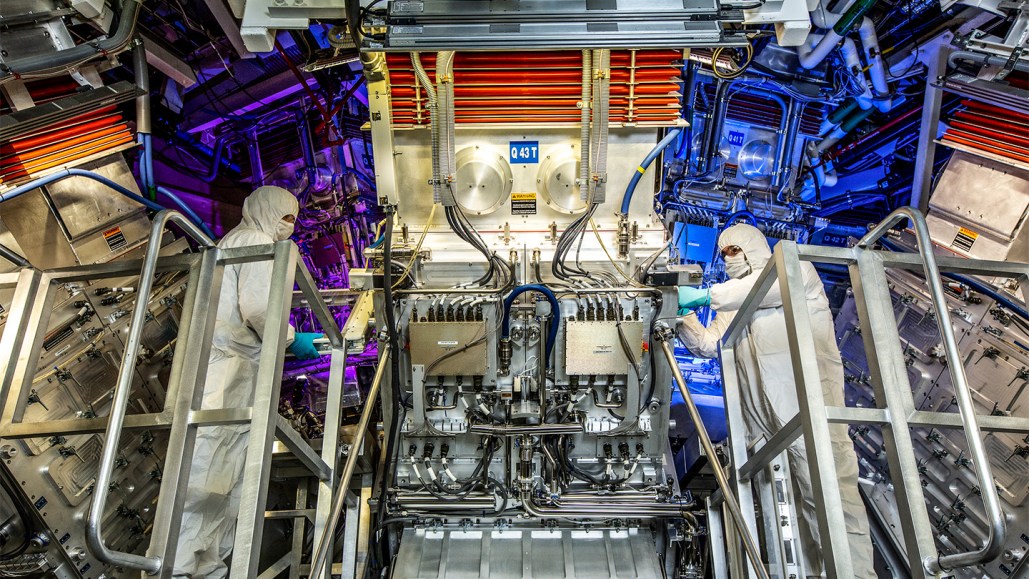Scientists Achieve Nuclear Fusion 'Ignition' for the First Time: Unveiling the Milestone

Some exceptional scientific precision was employed to achieve major progress in nuclear fusion.
Lawrence Livermore National Laboratory researchers made history in December 2022 by generating fusion reactions that produced more energy than they consumed. This experiment involved firing 192 lasers at a small chamber to initiate fusion reactions, a process where smaller atomic nuclei combine to form larger ones, which emitted more energy than the original lasers. This significant breakthrough, referred to as "ignition", has taken several decades to materialize.
Details of the series of experiments were shared in five peer-reviewed papers that were digitally published in Physical Review Letters and Physical Review E on February 5. Perfecting the conditions for optimizing laser performance and setting the stage for fusion required an incredibly high degree of expertise and modification.
Physicist Peter Norreys from the University of Oxford, unaffiliated with the research, described the work as "exquisitely beautiful", comparing the accomplishment to orchestrating a high-tiered symphony: every facet of the experiment needed precise synchronization and timing.
The scientists were also successful in identifying a previously theorized heating effect that can reveal more about the physics of violent occurrences like supernova explosions. Norreys suggests that despite some thinking physics is a "dry subject," he believes it truly pushes the boundaries of creativity.
Fusion processes, like those occurring in the sun, are a compelling energy source. Fusion power plants wouldn't emit greenhouse gases and, unlike present nuclear fission power plants that divide atomic nuclei to create energy, fusion plants wouldn't generate hazardous, lasting radioactive waste. Ignition is a crucial first step towards utilizing this power.
Producing fusion necessitates extremely high pressure and temperature conditions. In the experiment, lasers from LLNL's National Ignition Facility bombarded a hollow cylinder, or hohlraum, which is the size of a pencil eraser. The impact heated the hohlraum to a scorching 3 million degrees Celsius, generating X-ray emission. Inside this X-ray furnace, a capsule made of diamond housed the fuel, two heavy hydrogen variants known as deuterium and tritium. Radiation from the X-rays vaporized the diamond shell of the capsule, which led to the implosion of the fuel at speeds of around 400 kilometers per second, igniting the intense conditions necessary for fusion.
Previous experiments had been very close to achieving ignition. To progress further, the research team slightly extended the laser pulse, which fired at the target for just a few nanoseconds, which increased the laser pulse's energy from 1.92 million joules to 2.05 million joules. Instead of direct power increase, which could damage the facility, duration was extended.
The researchers also added around 7 percent thickness to the capsule's diamond shell — a difference of only a few micrometers — which slowed the capsule's implosion and let more advantage be taken from the lengthier laser pulse. Norreys praises this accomplishment as quite remarkable.
The symmetry of the implosion was altered due to these small changes and had to be adjusted. "It’s like trying to squeeze a basketball down to the size of a pea," according to physicist Annie Kritcher of LLNL, adding that this has to be done symmetrically within 1 percent.
Maintaining the symmetry becomes especially difficult because the laser blast fills the hohlraum with a jumble of electrically charged particles, or plasma. Before reaching the walls of the hohlraum, this plasma absorbs the laser beams, which disturbs the symmetry.
Kritcher and her team slightly modified the wavelengths of the laser beams to balance things out, allowing for energy transfer from one beam to another. This correction involved adjustments to the beam wavelengths by just angstroms - tenths of a billionth of a meter. Carolyn Kuranz, a physicist at the University of Michigan who was not connected with the work, deems this feat as "amazing," emphasizing that such “tiny tweaks make such a phenomenal difference.”
After all the tweaks and changes made, the final fusion reactions produced energy of about 3.15 million joules, which was roughly 1.5 times the input energy, according to Kritcher and colleagues in Physical Review E. The total energy needed to power NIF’s lasers is much greater, around 350 million joules. Despite NIF’s lasers not being designed for energy efficiency, this indicates that fusion for practical power generation still has a long way to go.
Another experiment in July 2023 used a higher-quality diamond capsule and obtained an even larger energy gain of 1.9, meaning it released nearly twice as much energy as went into the reactions (SN: 10/2/23). In the future, NIF researchers hope to be able to increase the laser’s energy from around 2 million joules up to 3 million, which could kick off fusion reactions with a gain as large as 10.
The researchers also discovered a long-predicted phenomenon that could be useful for future experiments: After the lasers heated the hohlraum, it was heated further by effects of the fusion reactions, physicist Mordy Rosen and colleagues report in Physical Review Letters.
Following the implosion, the ignited fuel expanded outward, plowing into the remnants of the diamond shell. That heated the material, which then radiated its heat to the hohlraum. It’s reminiscent of a supernova, in which the shock wave from an exploding star plows through debris the star expelled prior to its explosion (SN: 2/8/17).
“This is exactly the collision that’s happening in this hohlraum,” says Rosen, of LLNL, a coauthor of the study. In addition to explaining supernovas, the effect could help scientists study the physics of nuclear weapons and other extreme situations.
NIF is not the only fusion game in town. Other researchers aim to kick off fusion by confining plasma into a torus, or donut shape, using a device called a tokamak. In a new record, the Joint European Torus in Abingdon, England, generated 69 million joules, a record for total fusion energy production, researchers reported February 8.
After decades of slow progress on fusion, scientists are beginning to get their atomic orchestras in sync.




